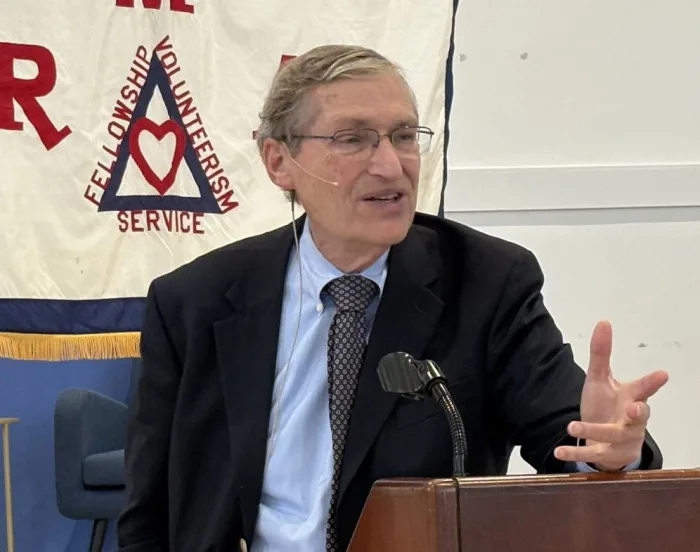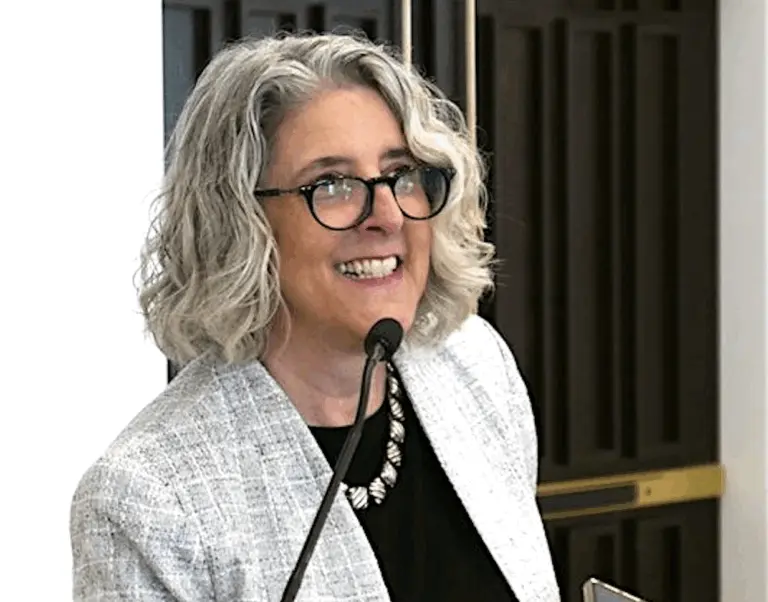
By Charles Shapiro
At the October 10 meeting of the Retired Men’s Association Spike Lipschutz introduced our speaker, Dr. Alan S. Kliger, whose talk was titled “Kidney Disease – A Tale of Two Miracles.” Dr. Kliger is Clinical Professor of Medicine, Yale School of Medicine. He served as Sr. VP Medical Affairs for Yale New Haven Health System, and was its Chief Quality Officer. He also served the Hospital of St. Raphael, New Haven as Chairman of the Department of Medicine, and later its Chief Medical Officer. Dr. Kliger served as the Chair of the American Society of Nephrology’s Excellence in Patient Care Advisory Committee and has co-authored more than 190 publications in peer-reviewed journals, with particular interest in dialysis, quality measurement, quality improvement and patient safety. Dr. Kliger received his medical degree from SUNY Upstate Medical University in Syracuse, NY, and is Board Certified in nephrology and internal medicine. In 2025, he was a Medal of Excellence awardee from the American Association of Kidney Patients. He has won numerous other awards, including from the National Kidney Foundation, and in their words “is nationally recognized for his clinical expertise in kidney function and care, and for his commitment to patient safety and to improving quality of care.”
The history of nephrology—the study of kidney disease—is a profound tale of medical impossibility turned lifesaving reality, a transformation so monumental it required intervention from the halls of Congress. That history was marked by two distinct “miracles.” Dr. Kliger began by noting that the first miracle, kidney dialysis and transplantation, is roughly 60 years old. He described the grim reality in 1968, when he was a junior medical student at a VA hospital in Syracuse. He tended to a young patient in his late 20s whose kidney function had plummeted to 8% of normal—a level insufficient to sustain life. At that time, end-stage kidney failure was effectively a death sentence.
Decades earlier, in 1943, Willem Kolff, had invented a machine capable of processing blood and removing toxins like urea. Kolff famously hid four of these early dialysis machines in a garden in Kampen, Netherlands, to prevent the occupying Nazis from finding them. By the 1960s, various forms of this technology offered a bridge to life for patients with acute kidney failure or those awaiting a transplant. Yet, the scarcity of these early treatments led to a grim era of medical rationing. Dr. Kliger recounted reading about committees—dubbed the “Death” or “God” Committees, by Time Magazine—in places like Seattle that were tasked with deciding who deserved the limited treatments. These groups often prioritized young, employed white men who were fathers, viewing them as vital assets to the community. Dr. Kliger’s own young patient in 1968 was denied this revolutionary treatment because he carried a diagnosis of schizophrenia, leading Dr. Kliger to witness his slow death.
The moral dilemma reached a tipping point when Congress intervened. Dr. Kliger highlighted the pivotal testimony of Shep Glazer, a young father who came to Washington to plead for funding for his life-sustaining dialysis treatments. In a highly dramatic moment reported in The New York Times, a dialysis machine was set up in the congressional committee room, and Glazer was connected to it. A colleague of Dr. Kliger, Jim Carrey, set up the machine, demonstrating the life-saving potential of dialysis right before the eyes of the lawmakers. This effort resulted in the 1973 passage of the H.R. 1 Bill, which mandated Medicare payment for dialysis independent of patient age, race, ethnicity, marital status, or any other arbitrary factors. This revolutionary move defined kidney care for decades to come. Today, 800,000 people in the U.S. and two million worldwide rely on this multi-billion-dollar enterprise.
For half a century, medicine focused on sustaining life once kidney failure had set in. But beginning around 2020, the second miracle had emerged, shifting the focus to prevention. This breakthrough involved SGLT2 inhibitors—a class of drugs initially developed for diabetes that affect the sodium and glucose pump in cells. While weak for controlling blood sugar, studies coincidentally showed that these drugs were powerful in protecting the heart and, critically, retarding the progression of kidney failure, even in people without diabetes. This effect was foreseen by Dr. Ralph DeFronzo, who predicted that cell energetics would have this outcome. This paradigm shift was further cemented by findings related to the semaglutides (known by brand names like Ozempic and Wegovy), which also significantly reduces the incidence of end- stage kidney failure. The latest modeling suggests combining these new medicines—such as SGLT2 inhibitors and GLP-1 receptor agonists—may yield additive benefits, stopping or dramatically slowing kidney disease progression for many patients.
Despite this optimistic future, Dr. Kliger noted serious obstacles remain, particularly in the slow translation of scientific discovery into widespread practice. Furthermore, because kidney doctors currently derive a large portion of their income (40-50%) from dialysis treatments, and the for-profit dialysis corporations are multi-billion-dollar entities, the success of these preventative medicines poses a threat to the current financial structure of kidney care. Dr. Kliger emphasized that new reimbursement models are needed to incentivize doctors to adopt these treatments upstream, noting that saving a patient’s kidneys from failing is far less expensive for the system than decades of dialysis.
The RMA’s next presentation, “Admiral Hyman Rickover: Engineer of Power,” by Marc Wortman, PhD, is scheduled for 11 AM on Wednesday, October 22, 2025. RMA presentations are held at Christ Church Greenwich, Parish Hall, 254 E. Putnam Avenue, Greenwich, CT 06830.
Known as the “Father of the Nuclear Navy,” Admiral Hyman Rickover (1899-1986) remains almost a mythical figure in the United States Navy. A brilliant engineer with a ferocious will and combative personality, he oversaw the invention of the world’s first practical nuclear reactor. As important as the transition from sail to steam, his development of nuclear-propelled submarines and ships transformed naval power and the Cold War. They still influence world affairs today. His disdain for naval regulations, indifference to chain of command, and harsh insulting language earned him enemies in the Navy, but his achievements won him powerful friends in Congress and the White House.
Marc Wortman, PhD, is a multi-award-winning independent historian and freelance journalist. He is the author of five books on the American military, technology, and leadership, most recently “The Greatest Capitalist Who Ever Lived: Tom Watson Jr. and the Epic Story of How IBM Created the Digital Age.” Previous books include the award-winning “Admiral Hyman Rickover: Engineer of Power,” “1941: Fighting the Shadow War,” “The Bonfire: The Siege and Burning of Atlanta,” and “The Millionaires’ Unit: The Aristocratic Flyboys Who Fought the Great War and Invented American Air Power.”
Marc has written for many publications, including Vanity Fair, Smithsonian, Rolling Stone, and Time. He has appeared on CNN, NPR, C-SPAN BookTV, History Channel, Curiosity Stream and other outlets. He produced the exhibit on Admiral Rickover now on display at the Submarine Force Museum in Groton, Conn, and is an Honorary Plank Holder for the USS Rickover (SSN-795).
Following college at Brown University, he received a doctorate in Comparative Literature from Princeton University. He lives with his family in New Haven.
To stream the presentation by Marc Wortman at 11 AM on Wednesday, October 22, click on https://bit.ly/30IBj21. This presentation will also be available on local public access TV channels, Verizon FIOS channel 24 and Optimum channel 79.
Note: The views expressed in these presentations are those of the speakers. They are not intended to represent the views of the RMA or its members.
RMA speaker presentations are presented as a community service at no cost to in-person or Zoom attendees, regardless of gender. Any member of the public who would like to receive a weekly email announcement of future speakers should send a request to members@greenwichrma.org. The RMA urges all eligible individuals to consider becoming a member of our great organization, and thereby enjoy all the available fellowship, volunteer, and community service opportunities which the RMA offers to its members. For further information, go to https://greenwichrma.org/, or contact info@greenwichrma.org.




